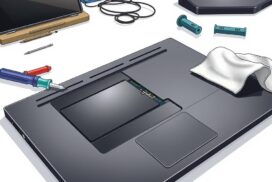Troubleshooting Guide: How to Fix a Frozen Laptop Cursor
An unresponsive mouse or touchpad can disrupt your workflow and slow productivity. Whether your cursor freezes mid-task or stops moving entirely, this issue often stems from software glitches or hardware malfunctions.
Common causes include outdated drivers, system overload, or even dirt interfering with the touchpad. Some users accidentally disable their pointing device, while others face deeper tech problems.
This guide provides structured solutions—from quick restarts to advanced driver updates. Keyboard shortcuts can help navigate Windows when the mouse fails. For brand-specific fixes, check manufacturer recommendations.
Addressing these problems systematically ensures smooth computing. Let’s explore the best troubleshooting methods.
Quick Fixes for a Frozen Laptop Cursor
A stuck pointer can halt productivity in seconds. Before diving into complex solutions, try these straightforward methods to regain control.
Check for Accidental Touchpad Disablement
Many laptops have a dedicated button or Fn key combo to toggle the touchpad. HP models often show an LED indicator—double-tap the touchpad to reactivate it.
Common function key combinations by brand:
| Brand | Shortcut |
|---|---|
| HP | Fn + F5/F7 |
| Lenovo | Fn + F6/F8 |
| Dell | Fn + F9 |
Use Keyboard Shortcuts to Re-enable the Touchpad
If the mouse fails, press the Windows key, type *mouse settings*, and hit Enter. Navigate with Tab and arrow keys to verify the touchpad is enabled.
For BIOS-level controls, restart and enter BIOS (usually F2/Del). Check for touchpad settings under *Advanced*.
Restart Your Laptop to Resolve Temporary Glitches
A reboot clears *temporary* system errors. Hold the power button for 10 seconds, wait 30 seconds, then restart. Disconnect external devices to rule out interference.
If the issue persists, proceed to deeper troubleshooting in the next section.
How to Fix a Frozen Laptop Cursor in Windows Settings
Windows provides built-in tools to troubleshoot unresponsive pointing devices. When the touchpad fails, keyboard shortcuts and system checks can restore functionality. Start with these steps before exploring hardware solutions.
Access Mouse Settings Without a Mouse
Press the Windows key + S, type “mouse settings,” and hit Enter. Use Tab and arrow keys to navigate. Verify the touchpad is enabled under Devices > Touchpad.
Inspect Touchpad Status in Device Manager
Press Win + X, select Device Manager, and expand Mice and pointing devices. Look for yellow exclamation marks—these indicate driver issues. Right-click the device and choose Enable if disabled.
Update or Reinstall the Driver
In Device Manager, right-click the touchpad driver and select Update driver. Choose automatic search or visit the manufacturer’s website (e.g., HP Support) for specific drivers. For persistent errors, try Roll back driver.
Pro Tip: Use Alt + Enter in Device Manager to view driver properties. Check the Hardware ID to confirm compatibility with your device model.
Hardware and Cleaning Solutions
Physical factors often contribute to an unresponsive cursor. Dirt, conflicting peripherals, or failing components may disrupt your touchpad. These steps help isolate and resolve hardware-related problems.
Clean the Touchpad to Remove Dirt and Debris
Grime or liquid spills can hinder sensitivity. Power off the laptop and dab a microfiber cloth with 70% isopropyl alcohol. Gently wipe the surface—avoid excess moisture.
Check for conductive debris like metal shavings. These may cause phantom cursor movements. Recalibrate sensitivity in settings post-cleaning.
Disconnect External Devices Causing Conflicts
Wireless mouse dongles or Bluetooth headsets might interfere. Unplug all peripherals and restart. Reconnect devices one by one to identify the culprit.
For USB conflicts, try different ports or troubleshoot hardware issues like power cycling.
Test with an External Mouse for Hardware Diagnosis
Connect a wired or wireless mouse. If it works, the touchpad may need replacement. Run brand-specific diagnostics (e.g., HP PC Hardware Diagnostics) for deeper checks.
Note: Persistent failures could indicate hardware damage. Consult the manufacturer for warranty options.
Advanced Troubleshooting Steps
Persistent cursor problems may require advanced system-level solutions. When basic restarts or driver updates fail, these methods isolate software conflicts and repair core files.
Boot into Safe Mode to Isolate Software Issues
Safe Mode loads only essential drivers, helping identify conflicts. Follow these steps:
- Hold Shift while clicking Restart in the Start menu.
- Navigate to Troubleshoot > Advanced Options > Startup Settings.
- Press F4 for Safe Mode or F5 for Safe Mode with Networking.
Test the trackpad in this mode. If it works, a third-party app likely causes the issue.
Reinstall or Roll Back Touchpad Drivers
Corrupted drivers often trigger unresponsive cursors. In Device Manager:
- Press Win + X, select Device Manager.
- Expand Mice and pointing devices, right-click your touchpad.
- Choose Update driver or Roll back driver if updates caused the problem.
Pro Tip: Download drivers from the manufacturer’s site before uninstalling.
Check for System Updates and Corrupted Files
Windows tools can repair damaged system files affecting hardware:
- SFC Scan: Open Command Prompt (Admin), type sfc /scannow, then press Enter.
- DISM Repair: Run DISM /Online /Cleanup-Image /RestoreHealth after SFC.
- Windows Update: Install pending updates under Settings > Update & Security.
For hardware issues, update BIOS/UEFI firmware via the manufacturer’s utility.
Conclusion
Resolving cursor issues requires a strategic approach. Start with simple steps like restarting or checking settings. Move to driver updates if the touchpad remains unresponsive.
For persistent problems, weigh repair costs against replacement. Regular maintenance—like cleaning and software updates—prevents future issues. Always back up data before major changes.
If hardware fails, consult manufacturer support or warranty options. Mastering keyboard shortcuts ensures productivity even during repairs. Follow this guide to keep your laptop running smoothly.
FAQ
Why does my laptop cursor freeze randomly?
A frozen cursor often results from driver issues, accidental touchpad disablement, or conflicting external devices. Software glitches or dirt on the touchpad can also cause this problem.
How do I re-enable my touchpad using keyboard shortcuts?
Press Fn + F5/F7/F9 (varies by manufacturer) or Windows key + I to open Settings and navigate to Devices > Touchpad to toggle it on.
Can an external mouse help diagnose cursor issues?
Yes. Plugging in a USB or wireless mouse helps determine if the problem lies with the touchpad hardware or software settings.
How do I check touchpad status in Device Manager?
Press Windows key + X, select Device Manager, expand Mice and other pointing devices, right-click your touchpad, and choose Enable device if disabled.
What if cleaning the touchpad doesn’t fix the issue?
If debris removal fails, update drivers via Device Manager, test in Safe Mode, or contact the laptop manufacturer for hardware support.
How can I prevent future cursor freezes?
Keep drivers updated, avoid conflicting peripherals, and regularly clean the touchpad. Check Windows Update for system patches that may resolve bugs.














